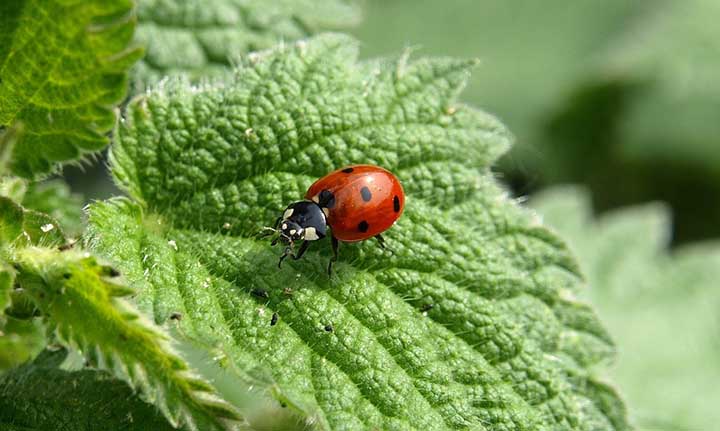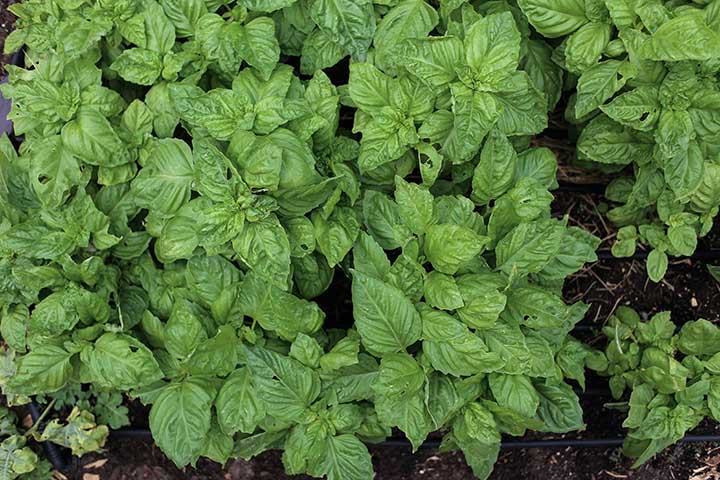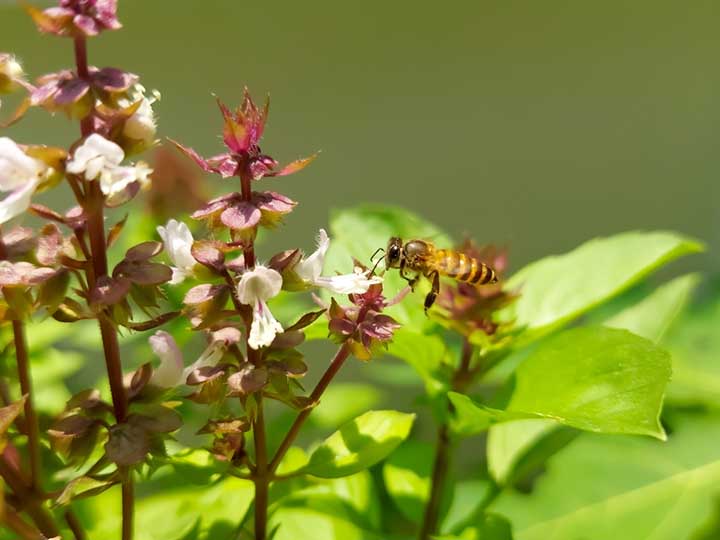Basil is a popular culinary herb. It is easy to grow and tastes good. However, you may want to know “Does basil attract bugs?” before deciding whether to grow it.
It is frustrating to plant herbs and have the bugs eat them before you get any. Some types of plants attract more bugs than others.
Does Basil Attract Bugs?
Yes, basil does attract bugs. Many of the bugs it attracts are beneficial insects, such as lady beetles, praying mantis, butterflies, hoverflies, and lacewings. However, it does get eaten by thrips, aphids, the Japanese beetle, whiteflies, flea beetles, leaf miners, cutworms, loopers, owlet moths, and spider mites.
Table of Contents
What Basil Growing Stages Attract Bugs the Most?
Most pests eat the leaves. The most common time to find bad bugs on your plant is when the basil plants actively grow new leaves.
Most beneficial insects feed on the bad bugs, so actively growing leaves are where you will find them. Many pollinators such as bees and butterflies feed on the pollen and nectar in the blooms, so they don’t appear until the basil blooms.
What Bugs Does Basil Attract?
As mentioned above, basil attracts a very diverse number of bugs. Here are the most common bugs attracted to basil.
Beneficial Bugs Attracted to Basil

Lady beetles
Lady beetles, also called ladybugs, are predators that specialize in eating aphids. Both the adults and larva eat aphids. If aphids are in short supply, they eat other small pests and their eggs.
Adults also feed on pollen and nectar. Lady beetles are small, round or oval, and domed. They are red or orange and black. The larvae look like miniature alligators and are black and red or orange.
Praying mantis
Praying mantis are stick-like predators that are the color of the plants they frequent. These apex predators eat beneficial and destructive insects, so they are a mixed blessing.
Butterflies
Many butterflies sip the nectar produced by basil flowers.
Hoverflies
Hoverflies are tiny black and yellow insects that mimic bees, so they are rarely noticed. Hoverflies eat aphids and other slow-moving insects.
The larva can eat 400 aphids before becoming an adult. The adults use the nectar and pollen produced by basil.
Lacewings
Lacewings are about ¾ inch long and green. They have large lace-like wings and large golden eyes. They are weak fliers and usually eat pollen, nectar, and the honeydew produced by aphids. The brown and white larva can grow to ½ inch.
Often called an aphidlions, the larva eats aphids and other soft-bodied insects, some caterpillars, and some beetles. If you pick up the aphidlion, it may pinch your skin with its mandibles.
Predatory Wasps
There are a wide variety of predatory wasps that visit basil. They sting their prey and bring it back to their nest, where it is placed in a chamber with a wasp egg and sealed.
Social wasps like yellowjackets, hornets, and paper wasps, will defend their nests by stinging. Solitary wasps such as mud daubers will only sting if handled or crushed.
Assassin Bugs
There are many species of assassin bugs. Most are gray or brown, but some are red and black. They attack many species of insects, including caterpillars, bees, flies, and other bugs.
These bugs bite if handled, and the bite is very painful.
Bugs That Damage Basil
Basil is attractive to many insect pests. Here are the most common.
Thrips
Thrips are long, slender, and tiny, with fringe on their wings. They pierce the plant leaves and suck the juices out of them. Stippling or silvering of the leaf is typical.
In addition, thrips feed on the leaves and shoots of basil which can cause them to be distorted and scared. These problems can make leaves fall prematurely and make them taste bad.
Aphids
Aphids are small, pear-shaped insects that are green, black, red, yellow, brown, or gray. Aphids like to feed on the sap of new growth, so young leaves and flower buds are often targeted.
Severe infestations cause twisted or curved leaves, yellow leaves, stunted or dead shoots, and poor plant growth.
In addition to the damage they cause, aphids excrete honeydew, a sweet sticky substance often colonized by sooty mold.
Japanese beetles
Japanese beetles are an invasive species. The larva eats turf roots. The adults are 1/3 to ½ inches long, with a shiny metallic green head and thorax and copper wing covers.
They can skeletonize leaves, leaving nothing behind but the veins. Without leaves, the plant will die.
Whiteflies
Whiteflies are tiny white-winged pests that suck the sap out of the underside of leaves. They produce honeydew, which can lead to a problem with sooty mold.
In addition, whiteflies can cause leaves to turn yellow, appear dry, or fall off. If you bump the basil plant and a cloud of white flies off, you have whiteflies.
Flea beetles
Flea beetles are tiny beetles that chew irregular holes in plant leaves. They can be black, bronze, bluish, or brown to metallic gray and have elongated back legs so they can jump like a flea.
Leaf miners
Leaf miners are a small fly. The larva lives inside the leaf and creates silver trails where they have eaten the contents of the leaf. The damage makes the leaf look bad but does not cause the plant much of a problem.
Cutworms
Cutworms come in different colors but are large grubs that curl in a C when disturbed. Since they feed on the stem of plants, young plants are most at risk.
Often the cutworm cuts the stem and kills the seedling. In addition, there are climbing cutworms that feed on leaves, buds, and shoots. They are the larva of moths.
Loopers
These green caterpillars have silver lines down the side and on the back. They create ragged holes in the basil leaves. They also contaminate the leaves with feces and bodies. Wash the basil leaves well before eating.
Spider mites
Spider mites are not visible to the naked eye. However, under a magnifying glass, they have eight legs. The two-spotted spider mite is the most common and is yellow-orange with two dark spots behind the head.
They are not insects, so that insecticides won’t kill them. The first sign of an infestation is often their webs on the underside of leaves.
They like hot, dry conditions, so watering your plant more to keep the soil moist can often be enough to get rid of them.
How Do I Get Rid Of Bugs That Are Eating My Basil?
Neem oil kills aphids, thrips, whiteflies, spider mites, caterpillars, beetles, and other pests. Spray the basil in the evening to avoid burning the leaves. Be sure to thoroughly wet all the leaves, including the underside. You may need to reapply the neem oil once a week for several weeks to eliminate the bugs.
Bacillus Thuringiensis (Bt) or Spinosad kills caterpillars such as loopers. Both of these are allowed in organic gardening.
Cutworms can be managed by spreading diatomaceous earth around the seedling when planting. Then, reapply after rain until the plant is large enough to handle some leaf loss.
How to Prevent Harmful Bugs from Eating Your Basil

You can do several things to prevent bugs from eating your basil. Here are a few tips.
- Remove plant debris from your garden promptly to remove overwintering sites for bugs.
- Floating row covers can prevent insect pests from laying eggs on your plants or flying in to bother them. Remove the row covers when the basil flowers so the pollinators can reach them.
- Keep weeds out of the garden so bugs can’t hide in them.
In conclusion, lots of bugs are attracted to basil. Many of these insects are beneficial and do not need to be controlled. Neem oil can kill most harmful bugs. Diatomaceous earth will kill cutworms. Both neem oil and diatomaceous earth are allowed in organic gardening.
